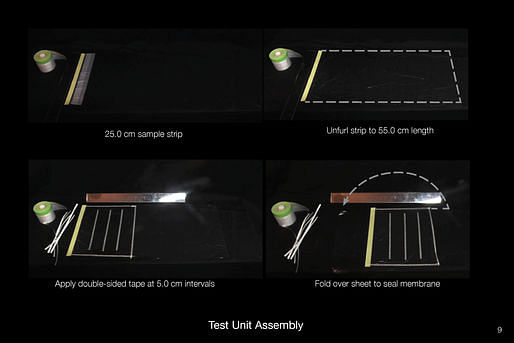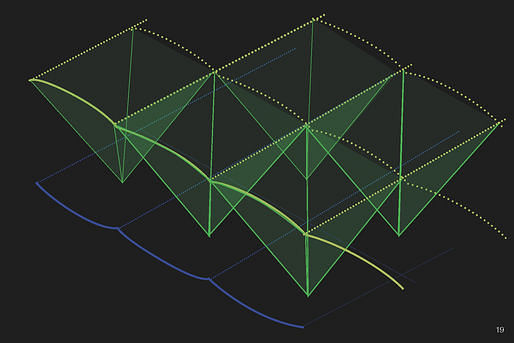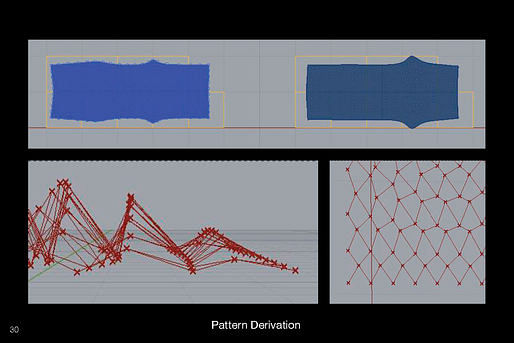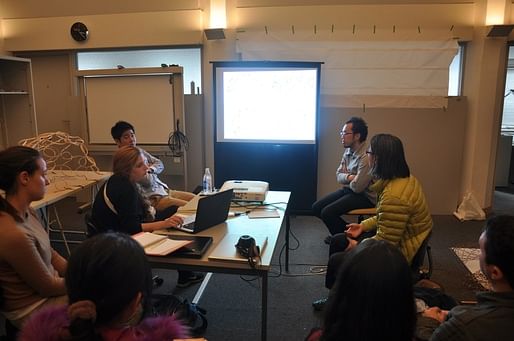
Oct '12 - May '13
With the the CirclePack pavilion ending mid November, my fellow first year students and I set about completing our individual projects for our Workshop One presentation, held on November 22nd (Turkey Day). As we don’t have any traditional studio classes until spring semester, this fall semester has been divided into a series of workshops aimed at developing our design research skills, while bringing everyone up to speed on the various software we will be using later in the program. The goal of Workshop One was to develop a canopy system based on the principles of nonlinear tensegrity pioneered by Buckminster Fuller, Frei Otto and Kenneth Snelson. The focus however wasn’t on the product, so much as the development of a system or design strategy - a “design tool” as Obuchi sensei prefers to call it - which allows a variety of different formal results to be derived from small manipulations to a basic material logic.
While we all took different meaning from these precedents, some holding closer to a traditional definition of tensegrity than others, for my own project I looked at inflatable membrane systems which utilize in effect only two materials, plastic sheeting and air, as the respective tensile and compressive, force-bearing elements. This simple relationship was then expanded into a design system by controlling how and where the two exterior membranes were joined by interior connection points (connected with double sided tape), producing an overall change to the form of the inflated system (I know it’s not very sexy, but think air mattress). From a variety of samples, general patterns and reactions could be learned and later put to use in the formal design of the canopy.




After initial experimentation with two ply inflated units, I determined that some additional method was needed to provide the system with enough depth to have some structural capacity and rigidity. Rather than use a cable system to increase the distance between top and bottom connection points, upon which many inflatable structures rely, I chose to utilize the same plastic sheeting composing the exterior, air-bounding membranes, while adding another design parameter as the connective tissue provided unique visual qualities within the system. The thinking goes that this can later be expanded with the project to respond to privacy/transparency, thermal, or other design criteria.







More tests followed, but the increased unit depth provided me greater confidence that the system would preform in a predictable and specified manner. From here I concentrated on developing and constructing the final form through a basic attempt to model the canopy digitally, in accordance with the general formal capabilities observed in the samples. In a way this was a reverse engineering of the design system by using the “assembled” form of the digital model to extract the 2D patterns necessary to construct the physical prototype. I began by modeling the two exterior membranes as surfaces in Rhino, then used grasshopper to construct the connection system between these surfaces as parametric rules. The resulting patterns could then be flattened through a combination of digital and analogue methods to obtain the construction patterns.







Overall, the canopy turned out to be more successful than I was initially expecting, with discrepancies between the physical and digital models occurring in quite predictable places - such as the translation of areas of the model containing compound curvature onto the 2D surface of the plastic sheeting. Some of the tape connection points, also began to fail at the higher pressures needed to fully inflate the canopy, a problem which proved frustrating yet something I hope will be straightforward in solving.
As we move forward into Workshop Two, the focus will shift to simulating the actual performance of the system digitally, as a way to greatly diminish the time of testing iterations of the various connection pattern to form relationships. It’s a realm of design in which I have little experience, and look forward to getting into the nuts and bolts of the software to really push the design and become fluent in a design technology.


The G30 is an English language, architecture and urbanism course offered through the University of Tokyo for foreign students. Led by former AA Design Research Lab Co-Director, Associate Professor Yusuke Obuchi, the program seeks to collaboratively advance architectural and urban design research through the symbiosis of digital technologies and material development.


1 Comment
I understand as a first year curriculum that this is focusing on design technique/technology/fabrication, but I am wondering where else the conversation is going in the program.
Every time one sees air architecture / inflatables / Bucky references / and installation size projects there is a question of true architectural implications. Has a stance been taken on the relation of the work to Archigram / Bucky / Yves Klien / etc? It is never too early to start to think about how a project fits into the greater discourse.
I ask this because it seems like so often Cool Wavy Wall Interesting Material Pavilions never reach beyond Cool Wavy Wall Interesting Material Pavilions. I think that this is often a sign of the curriculum over failure of students.
With that said, your project looks great. It looks like it was made with great care and precision. What is not sexy about air mattresses?
Block this user
Are you sure you want to block this user and hide all related comments throughout the site?
Archinect
This is your first comment on Archinect. Your comment will be visible once approved.